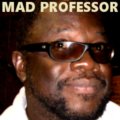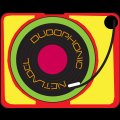| In
this two-part documentary, we are being
treated with the history of the Movement of
Rastafari, from the start to the situation
in contemporary Jamaica.
Some
elements in the video might be hard to
follow for non-Jamaicans, as there is no
subtitling. That's why this in-depth review
actually contains a description of the whole
two-part video.
It is a
must-see for everyone, if only to get a
better look on just how the music we all
love so much actually came into existence.
The video
opens with a central theme within the
Movement. We see Fillmore Alvaranga of the
Mystic Revelations of Rastafari group,
asking how it comes that countries like
England are so rich. They might have
officially abolished slavery, but the fruits
continues until this very day. Stolen from
Africa, in order to be used as richness over
here in Babylon.
We are then
taken to a Bobo Shanti camp, where a
groundation or gathering is ongoing. The
Bible is open and the drums are played. A
Rasta explains what they are doing, after
which we are taken into the study of Barry
Chevannes, a well known professor who speaks
about the tremendous influence of Rastafari
in the culture of Jamaica and beyond.
The
"dread combination" of Reggae and
Rastafari is usually seen as a minor
influence, but this video actually shows a
different story. We are being introduced to
Mortimer Planno, one of the founders of the
Movement. He speaks about his initial
contacts with Bob Marley and his influence
in Marley's spiritual development and
lyrical expressions.
The
legendary "One Love Peace
Concert", wherein Bob Marley called the
two main political rivals on stage in order
to make them shake hands and stop the
violence that terrorized the island, turns
out to be a the result of Marley's contacts
with Mortimer Planno, too. The concert
almost got him killed, as anonymous gunmen
tried to shoot the King of Reggae before he
could perform.
After a few
clips from the One Love concert, fast
forward a few decades into the ghetto's of
Kingston. The music changed, but how about
the situation? It turns out, that it is
still Rastafari who appeals to the needs of
the poor people. Poor people who are being
kept poor while being forced into political
violence that only serves the interests of
the power elite.
But still,
it remains hard for a Rasta to be a Rasta in
that society. Even though the positive
influence of the Movement is obvious,
there's still too much discrimination and
prejudice against the Rastaman. Part of this
is caused by people who do wear dreadlocks
but only for the looks. "We call them fashion
dread", as Rasta spokesman Ras Dago
says in the video.
However,
Rastafari may be fought against, the fact is
that the Movement has gone globally in the
mean time. In every nation and continent you
can find Rasta people.
And in the
same time, the Jamaican government is just
too happy with the financial income that the
island generates from tourists who want to
have a "Rasta Holiday". Still, the
Movement is still not officially recognized.
Many try to have it officially recognized as
a religion so that a Rasta can do his thing
in peace, but it has yet to come in Jamaica.
Ras Dago
continues to explain, just where the name
Rastafari comes from. It was the name of the
Ethiopian Emperor before he was crowned
Haile Selassie. The significance of a Black
King is then explained, for why is there
always a White Jesus and a White King and a
White Queen? Rastafari shows the people of
Jamaica that Black is Beautiful, that the
Creator has nothing to do with this
colonialist thing.
Someone who
had an enormous influence in Black Thinking,
was Marcus Garvey. He is also presented in
this video. The Movement of Rastafari kept
the Garveyite traditions until his
philosophies are now at the root of most
black liberation groups in the world today.
Leonard
Howell, one of Garvey's followers, started
to spread his believe that the Ethiopian
Emperor actually was God. This believe
continues to be present with a lot of
Rastafarians. The "Howelites"
started to congregate and the birth of the
movement was a fact.
Persecution
of the Movement was a fact, too. Members
were stoned to death, for example. The camps
were brutally looted, as we see one eye
witness describe just what happened. Leonard
Howell himself was thrown into a mental
hospital because the colonial downpressors
didn't like his message of Blackman
Liberation.
With a
society that is so brutally set against this
Movement, the Rastafarians started their own
communes, some of which continue to thrive
until this very day.
Fillmore
Alvaranga then tells us, when dreadlocks
came into the picture. He points to the Mau
Mau freedom fighters in Kenya, Africa. Barry
Chevannes tells us how the militancy of a
certain group back in the late 1940's also
started to carry dreadlocks as a sign of
protest against the powers of downpression
called Babylon system.
This also
triggered a reverend Claudius Henry who came
from America and started to preach doctrines
in Jamaica. Eventually, the colonial
government charged him with subversive
activity and it was said he wrote a letter
to Cuba asking for an invasion. As he was
charged, some people came and tried to
liberate him out of prison. In the resulting
gun fire, the colonial government had found
another reason to downpress Rastafari even
further.
When two or
three Rasta's would stand together at the
corner of the street, people were encouraged
to report it to the police. That enraged
Mortimer Planno, who together with a few
brethren wrote an appeal to the University
to come and research the Movement, in order
to see that there is no reason for the
persecution.
So said, so
done. It went further, as the Jamaican
governor was more or less forced to organize
a ten-man Rasta delegation to the African
continent. They went to Kenya and had
reconciliation with the descendants of
tribes that had sold the Jamaicans' fore
parents as slaves to the white slave
traders. they went to Ethiopia where Haile
Selassie told them that there was land for
them: Shashamane.
But then
there was another incident, in 1963. Again,
Rastas were accused of killing and putting a
gas station to fire. Three were shot, three
hundred were arrested for being a Rasta.
And, according to Fillmore Alvaranga, this
happened under the motto: "If the
prison can't hold them, throw them in the
cemetery"...
Rastas were
then more or less declared outlaws:
"wanted dead or alive". Literally.
Police harassed them everywhere, forcing
many to cut their locks. We see someone in
the streets agreeing to this policy.
Agreeing to the governor saying to
"arrest Rastas, dead or alive"...
"Persecution
elevated the movement's status among the
people", the narrator tells us. The
younger generation was attracted to the
Movement. Emperor Haile Selassie's visit to
Jamaica in 1966 also helped easing the
tensions.
The
Movement continued to develop, and the
different camps began to have different
doctrines and names: Nyabinghy, Twelve
Tribes, et cetera. But one thing remains
firmly: "repatriation is a must"...
|





























